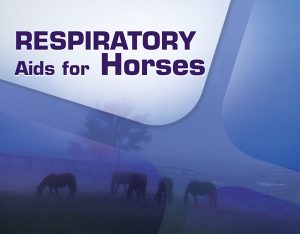Respiratory Aids for Horses
Click here to read the complete article
Many horses suffer breathing problems, airway or lung impairments due to dust, allergies, or disease. Just like humans, horses can benefit sometimes from breathing aids like nasal strips, inhalers and nebulizers. Dr. Larry Overly, known to most people as ‘Dr. Ricky’, is a track veterinarian at Los Alamitos. He says nebulizers and chelated silver products are often utilized to deal with lower airway disease and inflammatory issues in the lungs such as IAD—inflammatory airway disease. “There are various ways we combat IAD but first we need to find out what is actually causing the inflammation,” he says. It is important to pinpoint the source rather than just treat the symptoms.
“Are we dealing with allergens or bacteria? These are questions that need to be answered when we are trying to correct an issue. If a rider or trainer is using a nebulizer without first having a diagnosis of the problem, it’s just a blanket treatment that will probably help some of them—especially the horses that are staying in a stall most of the time,” says Ricky.
We’ve taken the horse out of its natural environment and have created conditions that trigger inflammation. “There’s a lot of dust, mold and pollens associated with hay and bedding, and just being in the barn itself. The horse is breathing in a lot of allergens, spores, fungi, etc. and all of these can lead to some form of inflammation. Nebulizer treatments are a shotgun approach to try to take care of an underlying problem even if the trainer or rider doesn’t know exactly what the problem is—simply trying to head off the inflammation,” he explains.
“The hope is to give an equine athlete a chance for a better performance, or more comfort for a horse with airway congestion. Earlier, it was a simpler management practice just to place these horses on Ventipulmin or albuterol to try to mitigate problems by using those products systemically. But Ventipulmin has the ability to actually change the athlete, and that’s the reason it can no longer be used in racing or at certain shows. In order to address upper respiratory issues we have to look for other aids—whether steroids or chelated silver products or bromides or atropine (to stop bronchial spasms),” he says.











